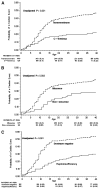Clinical aspects of type-1 long-QT syndrome by location, coding type, and biophysical function of mutations involving the KCNQ1 gene
- PMID: 17470695
- PMCID: PMC3332528
- DOI: 10.1161/CIRCULATIONAHA.106.665406
Clinical aspects of type-1 long-QT syndrome by location, coding type, and biophysical function of mutations involving the KCNQ1 gene
Abstract
Background: Type-1 long-QT syndrome (LQTS) is caused by loss-of-function mutations in the KCNQ1-encoded I(Ks) cardiac potassium channel. We evaluated the effect of location, coding type, and biophysical function of KCNQ1 mutations on the clinical phenotype of this disorder.
Methods and results: We investigated the clinical course in 600 patients with 77 different KCNQ1 mutations in 101 proband-identified families derived from the US portion of the International LQTS Registry (n=425), the Netherlands' LQTS Registry (n=93), and the Japanese LQTS Registry (n=82). The Cox proportional hazards survivorship model was used to evaluate the independent contribution of clinical and genetic factors to the first occurrence of time-dependent cardiac events from birth through age 40 years. The clinical characteristics, distribution of mutations, and overall outcome event rates were similar in patients enrolled from the 3 geographic regions. Biophysical function of the mutations was categorized according to dominant-negative (> 50%) or haploinsufficiency (< or = 50%) reduction in cardiac repolarizing I(Ks) potassium channel current. Patients with transmembrane versus C-terminus mutations (hazard ratio, 2.06; P<0.001) and those with mutations having dominant-negative versus haploinsufficiency ion channel effects (hazard ratio, 2.26; P<0.001) were at increased risk for cardiac events, and these genetic risks were independent of traditional clinical risk factors.
Conclusions: This genotype-phenotype study indicates that in type-1 LQTS, mutations located in the transmembrane portion of the ion channel protein and the degree of ion channel dysfunction caused by the mutations are important independent risk factors influencing the clinical course of this disorder.
Figures


References
-
- Moss AJ. Long QT syndrome. JAMA. 2003;289:2041–2044. - PubMed
-
- Sanguinetti MC. Long QT syndrome: ionic basis and arrhythmia mechanism in long QT syndrome type 1. J Cardiovasc Electrophysiol. 2000;11:710–712. - PubMed
-
- Tester DJ, Will ML, Haglund CM, Ackerman MJ. Compendium of cardiac channel mutations in 541 consecutive unrelated patients referred for long QT syndrome genetic testing. Heart Rhythm. 2005;2:507–517. - PubMed
-
- Bianchi L, Priori SG, Napolitano C, Surewicz KA, Dennis AT, Memmi M, Schwartz PJ, Brown AM. Mechanisms of I(Ks) suppression in LQT1 mutants. Am J Physiol. 2000;279:H3003–H3011. - PubMed
Publication types
MeSH terms
Substances
Grants and funding
LinkOut - more resources
Full Text Sources
Other Literature Sources
Medical

